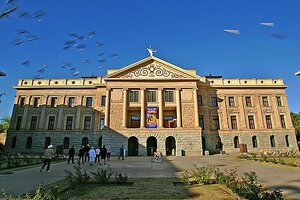To cut deficit, Arizona may sell its Capitol
The state could sell as many as 32 of its properties to help cover a $3 billion shortfall.

For sale? Arizona’s Capitol is just one property the state has weighed selling. It would likely then lease the property back.
Matt York/ AP/ File
Tucson, Ariz.
A state park with a spectacular limestone cave. A retirement home built in territorial days. Even state Capitol buildings in which laws have been crafted for a half century.
Piece by piece, Arizona is planning to sell off as many as 32 state properties to cover a historic $3 billion budget deficit. The state is in good company: California, Pennsylvania, and Connecticut are unloading state holdings, too.
It is an indicator both of the depth of the fiscal crisis facing states and the extraordinary lengths to which they will go to try to avoid steep tax increases.
In Arizona, the sales could put between $350 million and $700 million into state coffers this year – but it’s a quick fix. The state would pay between $60 million and $70 million to lease back many of the properties, meaning the transactions will cost taxpayers more in the long run.
“It just shows how deeply the recession really has affected state finances,” says Todd Haggerty, a research analyst with the National Conference of State Legislatures.
“Desperate times call for desperate measures,” adds Linda Lopez, the Democratic House minority whip from Tucson.
What's on the auction block
Arizona Gov. Jan Brewer signed the bill that approves the sale of state buildings on Sept. 3. Now, the state is deciding what to sell.
Properties around the state that may be sold and leased back include the House and Senate buildings, the Arizona State Hospital, the Arizona Pioneers’ Home retirement facility (built a year before Arizona gained statehood in 1912), and Kartchner Caverns State Park.
If it sells its Capitol buildings, only employees of the state agricultural laboratory would have to pack up and leave. Others would stay where they are as the state government leases back the properties over several years, eventually resuming ownership when the arranged terms end. The state has placed a total replacement value of roughly $1 billion on all the properties.
“Although there may be problems with the symbolism surrounding this, I think that at the end of the day, it’s something that the state has to do,” Ms. Lopez says. “We don’t have any choice.”
Arizona’s official historian disagrees.
Marshall Trimble is no fan of the cramped House and Senate buildings on either side of the historical copper-domed state Capitol, which is now a museum. But state properties “belong to the people of Arizona,” he says. “I just don’t think we have a right to sell these things.”
Enough value for that real estate?
On a more practical level, now might not be the ideal time to shed state assets, with Arizona in the midst of a deep real estate slump. Even so, the properties probably will appeal to institutional investors such as insurance companies and pension funds that seek guaranteed cash flow, says Chaz Smith of Colliers International, a commercial real-estate broker in Phoenix.
“Right now, the bond markets are just absolutely in horrible shape and people don’t know where to put their money,” he says.
State ownership represents a steady stream of revenue for investors, he says, adding that sale-lease mechanisms are not unusual. California, which faced a deficit of more than a $20 billion, is doing the same.
“We’re looking to the private sector expertise to help us liquidate these assets,” says Fred Aguiar, secretary of the State and Consumer Services Agency.
California hopes for bonanza
California is putting 11 properties on the market – like Arizona, selling them and leasing them back.
Mr. Aguiar has no doubt the assets will fetch top dollar: “These are unique properties, they’re some of our signature properties.”
The assets include the Ronald Reagan Building in Los Angeles, the Orange County Fairgrounds, and the Civic Center in San Francisco.
Pennsylvania bids farewell to two office buildings
For its part, Pennsylvania has no interest in regaining ownership of the two state office buildings it has sold in Philadelphia and Pittsburgh. It sold the 19-story Philadelphia building, constructed in 1958, for about $25 million to a developer who plans to transform it into condos, says Ed Myslewicz, press secretary for the Pennsylvania Department of General Services.
The 16-story Pittsburgh building, a year older than its Philadelphia counterpart, also is destined to house state residents after the $4.6 million sale closes several months from now, Mr. Myslewicz adds.
The buildings are old and in need of major repairs, so moving nearly 1,800 employees to leased office space saves taxpayer money and helps spur the local economy by putting the structures back on the tax roll, he says.
Back in Arizona, the sales pitch is just beginning. News that the state may sell part of itself already is attracting inquiries from various investors, says John McComish, House majority leader.
“They have money, they’re looking for solid places to invest, and the state of Arizona is still a pretty good investment,” the Phoenix Republican says.
